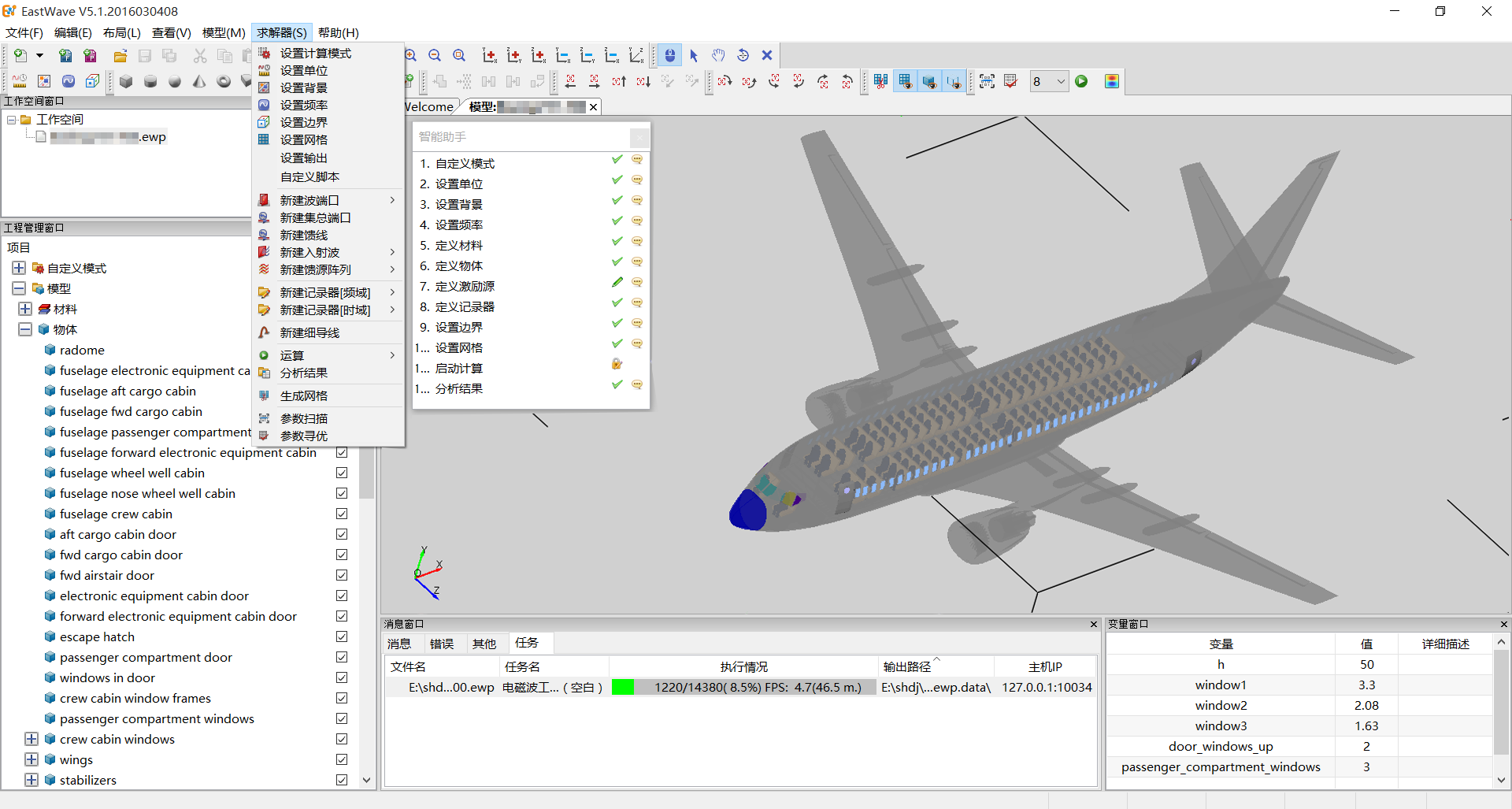· Usability
Predefined Workflows simplify the simulation workflow for some specific simulation tasks.
· Speed
Integrated fast computation techniques and efficient parallel computing enable fast and accurate simulation which makes automatic optimization of very large systems possible.
· Materials Modelling
EastWave supports modelling over a wide range of electromagnetic/optical materials.
User Interface

 Solver
Solver
EastWave includes a FDTD solver and a PO solver suitable for electrically large systems (scale of 10~1000 wavelengths) and even larger systems respectively. The PO module may also work together with FDTD solver for hybrid simulation.
Especially, EastWave developed fast computation techniques based on FDTD solver to specifically improve simulation efficiency of some common simulation tasks, such as radome effects, RCS, antenna array pattern. This has allowed accurate simulation of very large systems which was difficult to handle by common methods. These techniques are integrated in the easy-to-use Predefined Workflows.
Modelling
Structure
EastWave supports parameterized structure definition, which is the prerequisite of automatic parameter sweep/ optimization and advanced analysis.
 The structure can either be externally imported from CAD models (in STL/IGS/STP formats) or built from various primitive shapes and methods provided in GUI. The objects introduced can then be transformed (translate/scale/rotate) and reused (copy/group/array) which eases construction of complex structure.
The structure can either be externally imported from CAD models (in STL/IGS/STP formats) or built from various primitive shapes and methods provided in GUI. The objects introduced can then be transformed (translate/scale/rotate) and reused (copy/group/array) which eases construction of complex structure.
Materials
EastWave supports modelling over a wide range of electromagnetic/optical materials to allow various kinds of problems and phenomena to be simulated. Particularly, for an unknown material, Eastwave provides the tool to model the material by fitting its measured dispersion profile.
Supported material types include metals, dielectrics, magnetic materials, dispersive materials, lossy materials, anisotropic materials, graded materials, non-linear materials, gain materials, gyrotropic materials, metamaterials etc.
Excitation
 EastWave supports simulation of a variety of port excitations (modal wave, lumped port, etc.) and free space wave excitations (total-field scattered-field, Gaussian beam, etc.). The intended spatial field distribution and time waveform of the excitation can be generated by setting parameters in predefined modes or imported externally.
EastWave supports simulation of a variety of port excitations (modal wave, lumped port, etc.) and free space wave excitations (total-field scattered-field, Gaussian beam, etc.). The intended spatial field distribution and time waveform of the excitation can be generated by setting parameters in predefined modes or imported externally.
Monitor
Monitors are available to record time-domain or frequency-domain information of near-field at a point, across a plane, or far-field in a direction.
Specially, the “Synchronous Field Observer” tool enables to observe the field evolution synchronously as the simulation proceeds. This helps in early inspection of the simulation progress and better understanding of physics mechanism.
 Meshing
Meshing
Conformal meshing better models the curved structure surface within the mesh cell, while non-uniform meshing better models the fine structural features with lower computational cost than uniformly dense mesh.
Scripting Language
EastWave includes a scripting language which can be used for parameterized modelling, result analysis and visualization, data import and export etc.
Parameter Sweep and Optimization
EastWave supports multi-parameter multi-target optimization. User can choose from the simple local optimization option or hybrid global optimization option in the optimization tool. Evaluation function can be defined to find optimal balance between multiple targets.
Parallel Computing
EastWave supports MPI-based parallelization for clusters or multi-threading on PC/workstation.
Tests show almost linear scaling of the solver performance up to thousands of threads, taking optimal advantage of your hardware investments.